Grackles are a common sight in Florida, often seen in large flocks in urban areas. These medium-sized, black birds are known for their glossy plumage and raucous calls.
They are known to be aggressive and highly adaptable, making them successful urban dwellers. Despite their ubiquity, many people know little about the biology and behavior of grackles.
In this article, we will explore the history, habitat, and behavior of grackles in Florida, as well as the challenges they pose to both humans and native wildlife.
Grackles In Florida
There are 3 grackle species in North America: common, great-tailed, and boat-tailed. The ones found in Florida are common grackles and boat-tailed grackles.
1. Common Grackle
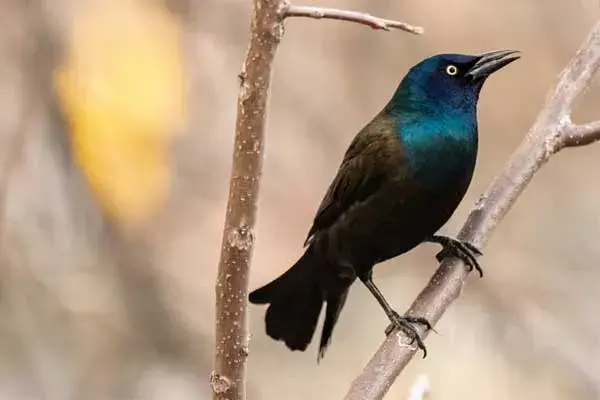
- Scientific Name: Quiscalus quiscula
- Lifespan: 17-22 years
- Wingspan: 14-18 in
- Length: 11-13 in
- Weight: 2.6-5.0 oz
Common grackles are one of the most widespread black birds with blue heads in the world.
They are found throughout most of North America east of the Rocky Mountains and they inhabit woods, fields, farms, and urban areas. Due to their vast range, they have evolved into 3 subspecies that vary in color. One of them, known as the Florida subspecies, is iridescent green.
Identify common grackles by their long, keel-shaped tails, dark beaks, and yellow eyes. Males have glossy black plumage with a blue-green sheen on their heads; females are less iridescent and are mostly brown.
Common grackles are year-round residents of Florida and can be seen around woods, fields, farms, and urban areas of the state throughout the year.
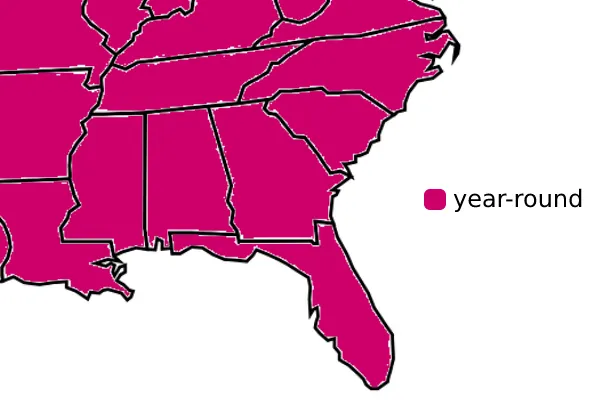
These medium-sized backyard birds are classified as songbirds because they have all the vocal equipment of a songbird, not because they have beautiful songs. Their song is a high-pitched rising “readle-eak” screech that sounds like a rusty gate opening.
Common Grackle Song | Source: Jonathon Jongsma, CC BY-SA 3.0, via Wikimedia Commons
Some popular dailies describe grackles’ songs as sounding like “everything from a squeaky door hinge and explosions of static from a radio left on at high volume to laughing whistles to monkey-like rattles.”
These birds can also mimic the sounds of other birds or even humans, although not as well as northern mockingbirds can, for example.
Common grackles are omnivores and feed on insects, minnows, frogs, eggs, berries, seeds, and grain. To satisfy their diverse diet, they will forge in different places, from agricultural fields and feedlots to suburban neighborhoods, parks, city trashcans, and streets.
Many people have told the story of how grackles patiently wait for someone eating outside to turn their head away before the bird flies in to steal their favorite treat, the french fries.
It seems humans and grackles aren’t that different, after all.
A 2012 study by the National Audubon Society discovered that the common grackle population declined from an all-time high of 190 million in the 1970s to under 70 million today. Such a 60% drop has resulted in the International Union for Conservation of Nature (IUCN) listing them as Near Threatened.
Common grackles are usually monogamous species and form pairs early in the spring. They nest in large colonies from late February to April and hide their nesting sites among branches of dense trees or shrubs near water.
In case you come across a bulky open cup made of weeds, grass, twigs, and some mud, that is lined inside with fine grass, there’s a chance it is of common grackles. Females usually lay 2-6 pale blue eggs that are blotched with brown.
Fun Fact: A group of grackles is called a “plague”.
2. Boat-tailed Grackle
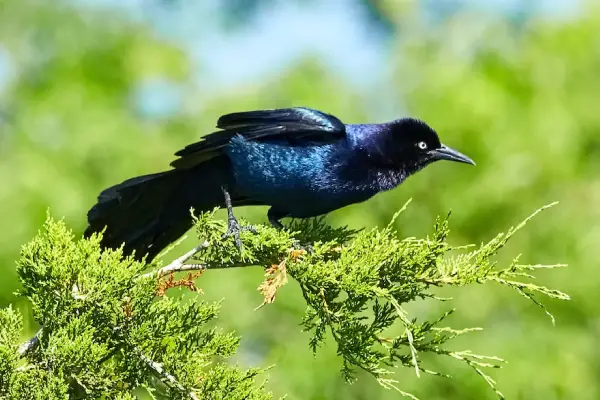
- Scientific Name: Quiscalus major
- Lifespan: up to 12 years
- Wingspan: 15-20 in
- Length: 15-17 in
- Weight: 5.8-8.8 oz
Boat-tailed grackles are large blackbirds found on the coasts of the Southeastern USA. They inhabit coastal saltwater marshes and breed in saltmarshes, marshes along rivers, lakes, impoundments, or ponds, and in nearby upland habitats.
Identify male boat-tailed grackles by their iridescent black plumage, greenish-blue wings, keel-shaped tails, black downcurved beaks, and brown or yellow eyes.
Depending on the region, their eye color varies: brown in Florida and along the western Gulf Coast or yellow along the Atlantic coast and the eastern Gulf Coast.
Females have brown plumage, darker wings and tails, and pale brown breasts – they are almost two times smaller than males.
Boat-tailed grackles are permanent residents of Florida, ranging throughout most of the state, except for the northernmost parts.
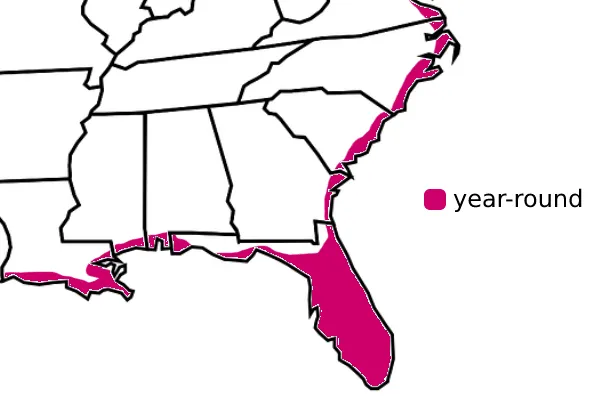
Compared to common grackles, boat-tailed grackles are bigger and have longer tails and beaks. What makes them special is that they venture inland only in Florida.
They are a noisy species making several calls: quiet “chicks,” rough squeaks, rattles, chatter, and whistles. Their song consists of a series of loud “jeeb–jeeb” notes.
Boat-tailed Grackle Call | Source: G. McGrane, Public domain, via Wikimedia Commons
These gregarious birds are diurnal (active during the day) and gather in huge flocks to feed and roost. They forage on the ground and have a diet consisting of small crabs, large insects, worms, seeds, grain, shrimps, frogs, turtles, and food they scavenge from humans.
Boat-tailed grackles will also steal food from other birds.
They are very aggressive during the breeding season and chase away hawks and turkey vultures. Males are polygamous, they mate with several females that build nests on their territories; females will also mate with male strangers from the colony.
In case you come across a cup-shaped nest made of sticks, weeds, grasses, and Spanish moss that has 2-4 pale greenish blue eggs with dark marks, there’s a big chance they belong to boat-tailed grackles. Females incubate the eggs alone for 13-14 days and have 2-3 clutches a year.
Boat-tailed grackles nest in Florida from early March to late July with over half of all clutches laid between March and April.
According to some estimates, boat-tailed grackles have a global population of around 3.7 million birds and are listed as species of Least Concern by the IUCN.
Birds In Florida Commonly Mistaken For Grackles
1. Brewer’s Blackbird
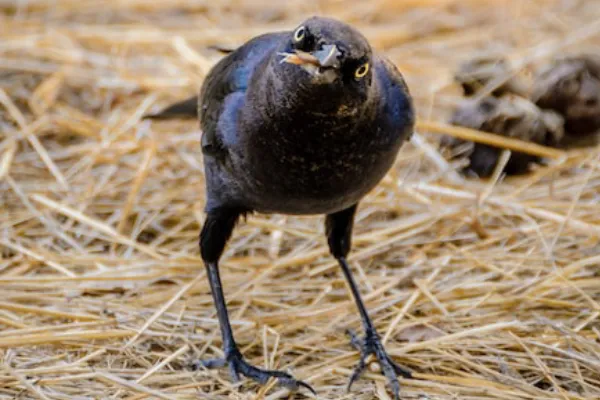
- Scientific Name: Euphagus cyanocephalus
- Lifespan: up to 12 years
- Wingspan: 15.5 in
- Length: 8–10.3 in
- Weight: 2.2 oz
Brewer’s blackbirds are common around open and semi-open areas, often near water, across central and western North America. These small black birds that were named after the ornithologist Thomas Mayo Brewer have long legs, round heads, and long, thick-based bills.
Male Brewer’s blackbirds are black with iridescent purple heads and necks and have glossy bluish-green highlights on the rest of the body, making some bird watchers mistake them for common grackles. Females are brownish-gray and don’t have the males’ iridescence.
Here’s how to differentiate the two species. Common grackles are bigger than Brewer’s blackbirds and have longer tails. Male common grackles have greenish heads in Florida while Brewer’s blackbirds have purplish ones. Female Brewer’s blackbirds have duller brown heads compared to female common grackles.
They are common around bird feeders and can be also seen sitting perched up high on utility lines and tree tops looking for their next meal. They are omnivores and feed on seeds, insects, and some berries.
2. Brown-headed Cowbird
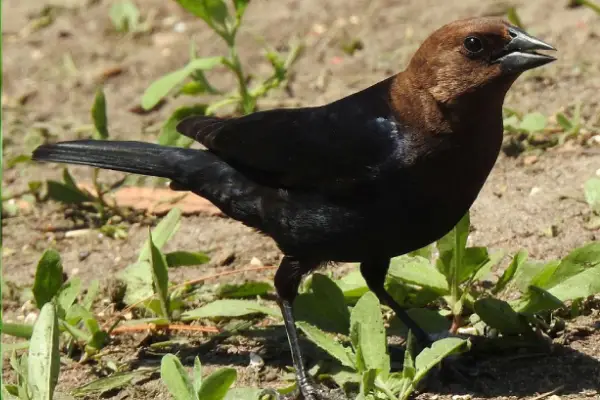
- Scientific Name: Molothrus ater
- Lifespan: up to 17 years
- Wingspan: 12-15 in
- Length: 6.3–8.7 in
- Weight: 1.1–2.1 oz
Brown-headed cowbirds are small blackbird with stout bills and short tails.
Males are iridescent black and have brown heads while females are slightly smaller and have dull gray plumage with pale throats and very fine streaking on their underparts. They are also smaller than common grackles and have shorter tails. Males have different head colors (brown vs green-blue in common grackles).
Brown-headed cowbirds have a fascinating way of raising their young. Instead of building nests, they lay their eggs in the nests of other small passerine birds (perching birds), while often kicking the host’s eggs out.
They do not discriminate and will lay eggs in nests of over 200 species of birds, including different birds of prey and even hummingbirds. The host will raise young cowbirds instead of their own young. Some birds might realize this trickery and just puncture or throw the eggs out of the nest. Other birds, like the yellow warbler, will simply build a new nest over the top of the old one as they are too small to get the cowbird eggs out.
Brown-headed cowbird females can lay up to 36 eggs in a season and this egg-laying behavior is known as brood parasitism.
These birds are common around open woods, farmland, and stockyards of North America and can be often seen walking on the ground in pursuit of food. Brown-headed cowbirds are omnivores and primarily feed on seeds and insects; they will also visit bird feeders.
During winter, they can be seen in flocks with other blackbirds; scientists discovered one mixed roost in Kentucky with over five million birds.
3. Bronzed Cowbird

- Scientific Name: Molothrus aeneus
- Lifespan: n/a
- Wingspan: 13 in
- Length: 7.3-7.9 in
- Weight: 2-2.4 oz
Bronzed cowbirds are small blackbirds commonly found around farmland, brush, feedlots, and open habitats of North and Central America. Like brown-headed cowbirds, bronzed cowbirds lay eggs in the nests of other birds.
Male bronzed cowbirds are around 7.9 in long, weigh 2.4 oz, and have glossy black plumage. Their eyes are red in the breeding season. Females are smaller, around 7.3 in long, have dull black plumage and brown underparts, and brown eyes.
Bronzed cowbirds resemble common grackles but are not as slim or elongated. They also have red eyes while common grackles have golden ones.
These highly social birds can be seen foraging, resting, and roosting in flocks with over 100 birds. They are omnivores and feed on seeds and insects, along with snails.
4. Fish Crow

- Scientific Name: Corvus ossifragus
- Lifespan: up to 14 years
- Wingspan: 33.1 in
- Length: 14.2-15.8 in
- Weight: 8.7–11.3 oz
Fish crows are crow species found in the eastern and southeastern United States. These birds that are endemic to Florida look like smaller versions of the American crows.
Fish crows have sturdy legs, dark brown eyes, and broad wings; their plumage is all-black and their heavy bills measure around 1.8 inches long.
Fish crows resemble boat-tailed grackles but are overall heavier and have larger bodies. They also have thicker bills and shorter tails compared to boat-tailed grackles.
They are found around coastal marshes and beaches, rivers, inland lakes, river banks, and urban areas. Listen for their nasal “ark-ark-ark” and mechanical rattle calls.
They have a particular habit of robbing nests – fish crows will raid the nests of many kinds of waterbirds and songbirds or dig up turtle eggs.
Fish crows are omnivores that feed on fish, crabs, shrimps, fruits, grains, peanuts, and even human scrap. They often forage on the ground or in shallow waters where they can be seen plucking food out of the water with their feet.
Read More: Grackles found in Texas
Summary
This concludes our list of grackles in Florida. Hopefully next time you see these, you will recognize any of them with ease!
Read More: Grackle species that live in Arizona